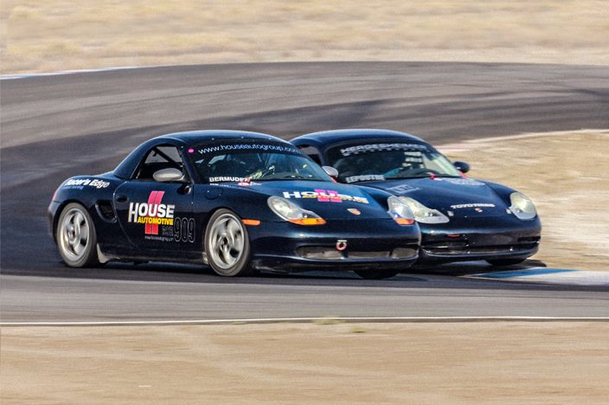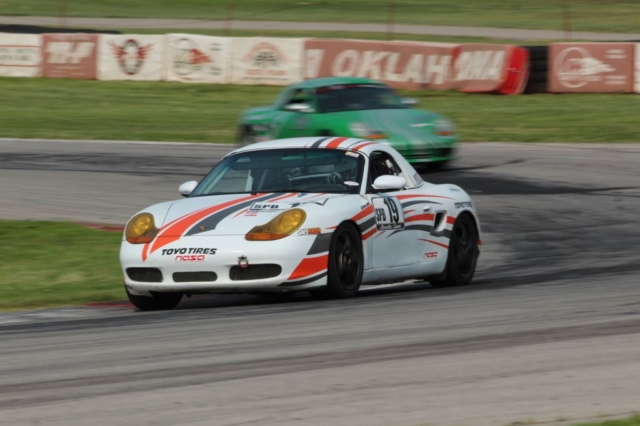For those tired with the anemic engines of a Spec Miata or the somewhat wayward handling of its budget racing peer, the Spec E30, there’s another option. Spec Boxster takes a modern Porsche 986, trims weight, adds sex appeal, and gives aspiring drivers the chance to wrestle with a mid-engined Porsche for a bit more than the aforementioned two platforms – one can have a competitive Spec Boxster built for them for somewhere in the ballpark of $30,000, which isn’t much more than a top-end Spec E30.
The Spec Boxster uses the ’97 – ’99 Boxster as a donor car. Modifications permitted to the M96.20 engine are an underdrive pulley, alternative flywheels, removal of air injection, a new IMS bearing, an Accusump to prevent oil starvation, a Boxster S oil cooler, and an additional center radiator.
Where footwork is concerned, the list of allowable modifications includes GT3 A-arms and Bilstein PSS9 shocks. A transmission cooler, as well as a Sachs clutch kit are approved, and so is the Spec Boxster short shift kit.

Low power, poise, and plenty of grip allow for race-long duels like this one. Photo credit: Winding Road
In short, the modifications are oriented towards durability, not outright performance. Nevertheless, a short wheelbase, an engine in the right location, and sticky Toyo RR tires mean incredible cornering capability. Plus, a 2,600-pound curb weight, 180 wheel horsepower, and the torque offered by a 2.5-liter flat-six mean the Spec Boxster not exactly breathless when the right foot floors the throttle.
It’s a wonderful package since it doesn’t emphasize high-speed gains too much, and the mid-engined layout offers precision but also demands a delicate touch. Unfortunately, this tricky layout gets the better of some drivers who are just a little too keen for their level of talent, as we see here.
In example 1, the driver of the camera car manages to drive smoothly and patiently, but the same can’t be said about driver of the car he’s chasing. Unfortunately, the mid-engined layout of the Boxster is sometimes a bit challenging to master; it likes to let go when the throttle is lifted at higher speeds and can be challenging to catch.
As the lead car brakes and turns in at 00:18, the rear is already beginning to overtake the front. Mid-engined cars are especially sensitive to weight transfer, so any abrupt steering input mixed with a strong brake application, or even a lift off the throttle, can send a car sliding. The camber of the road exacerbates this problem, and the driver cannot steer quickly enough to recover from the slide. Failing to catch the car, it rotates the other way, then a slow set of hands send it back once more to the left – into the path of the camera car. Unfortunately, target fixation, overconfidence, and little time to react ended in a pretty violent crash. On the upside, there’s no denying these cars are built sturdily!
Collision No. 2: as the camera car approaches the corner entry, the culprit can be seen making a dive to the inside through his mirror. Not only is this dive a little too late – he should have been alongside well before the turn-in point – he’s too fixated on the camera car to brake enough and avoid the blue Boxster in front. In this instance, the pass was never going to work, and it should’ve been postponed until another corner – trying to take two at once is usually a high-risk move.
Number Three shows just how sensitive these cars are at high speed. As the driver navigates the esses at Circuit of the Americas, a downshift followed by a delayed lift off the throttle means a lightened rear which quickly begins to rotate. Here, the downshift needed to be completed before the turn-in point, and the rear end needed to be balanced with a gentle application of the throttle before any direction change was made. Chucking a Boxster into a high-speed corner is only going to end one way, unfortunately.
On the upside, this nervous sort of behavior is matched with incredible traction, but the car must be driven carefully to exploit it. Mid-engined cars, sensitive as they are, force a driver to be gentle and progressive with their inputs. The window between grip and slip is fairly small, but once a driver learns to play around inside it, they’re subjected to a world of driving delight.




















